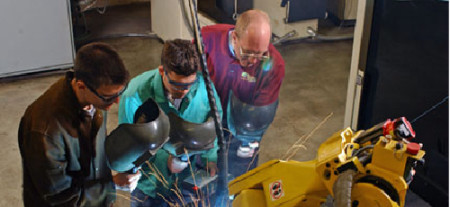 Ferris State University is one of the top universities in the United States for welding.
Ferris State University is one of the top universities in the United States for welding.
Throughout the entire country, there are six universities which offer a welding-based program. Of those six, Ferris State University, which has the largest such program, is considered by many to be the best school to receive an education in welding.
Welding in any capacity has become a hot commodity throughout the country for many reasons. In the age where an increasing number of jobs are being given to machines, the industry is sorely in need of college grads with a degree in welding technologies to give their companies’ products what robots can’t: the human touch.
“We’re getting to the point where all of the welders who came up without the heavy use of machines are starting to retire,” said Jeff Hardesty, the adviser for both Welding Engineering Technology Programs. “We have robots that can certainly do a lot, but we need skilled human welders to do what they can’t: to get the angles machines can’t get.”
With more baby boomers retiring, many companies are looking to fill their staff with young but experienced welders (who stand to have a starting salary around $65,000) because what’s rare is what’s in high demand. So naturally, as with nursing a few years ago, people currently in college are jumping at the chance to get such a readily available job.
First and foremost, Ferris students looking to go into the welding business should know Ferris doesn’t offer a degree simply called “welding.” There are two degrees available depending on how far one wishes to take their welding education.
The first is an associate’s degree in welding technologies, which will enable students to work as a welding supervisor, an inspector or a robot programmer with a set of basic welding skills. The second is a four-year bachelor’s degree in welding engineering technology.
“Our program teaches students more than just welding,” Hardesty said. “We don’t have them put in the hours it would take to be a totally awesome welder, but we give them enough practice to be good ones. We think it’s more important that students understand the science and physics of what goes into the metals and all other parts so that they’re able to do the set-up job or program the robot to achieve the right angles. We don’t teach students to go out and weld for a living; we go beyond that.”
For Ferris’s welding technologies program, students have come from across the country to study the craft before going into the field. The reason so many students choose to come to Ferris is because Ferris is the only school with an accredited welding engineering technology degree, which puts the program at the top of the list for aspiring welders.
While Ferris’s welding engineering technology program may be the most sought-after program of its kind, it does not teach students to actually work as welders. Instead, it teaches students to work alongside current technology while learning to apply what Hardesty calls “adaptive human logic” when necessary.
The decision as to which of those is the more valuable direction – that’s up to the student.
